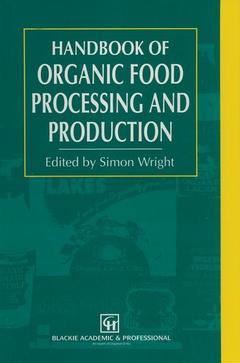Handbook of Organic Food Processing and Production, 1994
Langue : Anglais
Auteur : Wright S.

The increasing interest in organic foods has created a need for this book, the first practical manual to cover the processing of organic food and drink. The book shows how a company can process organic foods, emphasising economic and legal considerations. The authors have been selected for their extensive 'hands-on' experience of organic food processing. By demystifying the processing of organic foods this book will encourage those from outside the current organic food industry to become involved. An initial introduction to organic food is followed by a review of organic legislation (chapter 2) and the organic certification process (chapter 3). The following six chapters cover the major organic commodity groups: Fruit and Vegetables, Cereal Products, Meat and Meat Products, Dairy Products, Other Processed Foods and Alcoholic Drinks. Chapter 10 is devoted to developments in the USA. Finally there is an extensive directory, giving details of the major players and organic organisations throughout the world. The book will appeal to technical and marketing personnel in organic food and drink processing companies, as well as their counterparts in companies who want to become involved. Other people who will find this book of interest include retailers who sell organic foods; farmers who grow organic crops; lecturers and students of Food Science and Food Tech nology; lecturers and students of Agriculture; and anyone who wants an introduction to this rapidly developing sector of the food industry.
1 Introduction.- 1.1 Introduction.- 1.2 Organic farming.- 1.3 Conversion.- 1.4 Conservation grades.- 1.5 The cost of organic farming.- 1.6 How subsidies make organic farming uncompetitive.- 1.7 How does it work?.- 1.8 First World agriculture and Third World poverty.- 1.9 Fair trade and organic farming.- 1.10 History of the UK organic movement.- 1.11 Market size and share.- 1.12 Producers, processors and marketeers.- References.- 2 UK and European Community (EC) legislation.- 2.1 Introduction.- 2.2 Situation in the UK and the EC prior to EC legislation.- 2.3 Development of EC legislation.- 2.4 Summary of EC legislation as at 30 October 1993.- 2.5 Structure of the EC legislation.- 2.6 Future developments on standards.- 2.7 Aid for organic farming.- 2.8 Overview.- References.- 3 Organic certification and the importation of organically produced foods.- 3.1 Introduction.- 3.2 Organic certification and its importance.- 3.3 Organic standards and certification protocol.- 3.4 Development of organic certification as a legal requirement.- 3.5 The structure of organic certification schemes in the EU.- 3.6 Certification protocol.- 3.7 Imports of organically produced foods.- 3.8 The dynamics of organic certification.- Acknowledgement.- References.- 4 Fruit and vegetables.- 4.1 Introduction.- 4.2 Market structure and history.- 4.3 Availability.- 4.4 Growing systems compared.- 4.5 Types of market.- 4.6 Imports.- 4.7 Market overview.- 4.8 The future.- 5 Cereal products.- 5.1 Principal crops.- 5.2 Producing organic cereals.- 5.3 Processing requirements.- 5.4 Existing products.- 5.5 Summary.- 6 Organic meat and meat products.- 6.1 Introduction.- 6.2 Legislation.- 6.3 Organic meat production.- 6.4 Processing and marketing organic meat.- 6.5 Some practical processing and marketing considerations.- Acknowledgement.- References.- 7 Dairy products.- 7.1 Introduction.- 7.2 The significance of milk.- 7.3 Milk quality.- 7.4 Animal husbandry on an organic dairy farm.- 7.5 Liquid milk processing.- 7.6 Cheese production.- 7.7 Yogurt making.- 7.8 Cream and butter production.- 7.9 Ice-cream and frozen yogurt production.- 7.10 Marketing organic dairy products.- 7.11 Market development.- 7.12 Types of organic dairy units.- 7.13 Legislation.- 7.14 Summary.- 8 Other organic processed foods.- 8.1 Introduction.- 8.2 Organic spreads.- 8.3 Organic juices and grain syrups.- 8.4 Organic sauces and pickles.- 8.5 Organic ready meals.- 8.6 Organic snack items.- 8.7 Organic oils, vinegar and soya sauce.- 8.8 Dried organic products.- References.- 9 Alcoholic drinks.- 9.1 Introduction.- 9.2 Consumer demand for organic wines, beers and spirits.- 9.3 Problems with non-organic alcohol.- 9.4 The producers.- 9.5 The merchants.- 9.6 The future.- Appendix: Commonly used additives in wine-making.- Further reading.- 10 The USA perspective.- 10.1 Market overview.- 10.2 Legislation.- 10.3 Future trends.- References.- 11 Directory of organic organisations.- 11.1 UK.- 11.2 International.- 11.3 Trade shows.- 11.4 Other useful addresses.- Further reading.- General index.- Index of company names.- Index of organic legislation and regulations.
Date de parution : 10-2012
Ouvrage de 207 p.
15.5x23.5 cm
Thème de Handbook of Organic Food Processing and Production :
Mots-clés :
agriculture; food; food industry; food processing; food science; processing
© 2024 LAVOISIER S.A.S.



